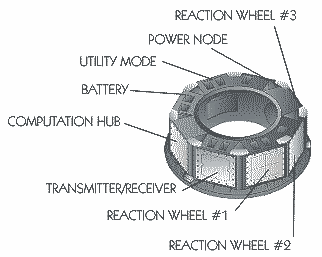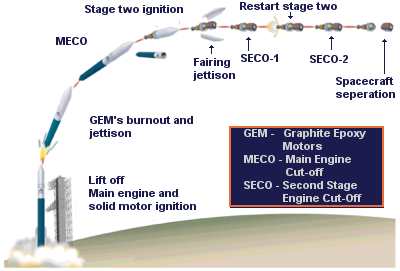


STRUCTURES - STRESS, STRAIN & YIELD?
![]()
Why are structures significant for XMM??
XMM is a telescope which is a structure. It is also a scientific instrument which implies that the specification for its construction is much more demanding than the sorts of structures with which we are far more familiar such as buildings. A typical telescope comprises two parts; something that focuses the light such as a lens or a mirror, and something which detects and records the position of the image. These two components have to be kept rigidly and precisely apart, often at some distance from each other. This require a structure. If such a structure is damaged or distorted the telescope becomes misaligned and does not work.

This satellite design is called SmexLITE and was designed by NASA. It is highly versitile and has been used as the main bus (main shell) for many satellite missions including Trace, Fast and Sampex. Not only does it survive the launch sequence but also it only weighs 75kg!
From a structural point of view the fact that the XMM telescope has to operate in space has some advantages and some disadvantages. In many respects, although space is often considered to be a hostile environment, for structures it is fairly benign. This is because in space structures are weightless and therefore do not have to support themselves against the force of gravity as all earth bound structures do. This is a tremendous advantage. However, to get to this benign environment they have to traverse a really savage environment; that of the launch. Here the array of forces that come into play produce accelerations (or g forces) that can be many times the single g-force that we are used to in our everyday lives and structures are in real danger of being torn apart if they are not designed well enough.

During the launch, the payload will be subject to very high g-forces, especially at MECO and SECO.
Most structures can be well described simply in terms of two properties, their strength and stiffness, and XMM is a prime example of that. It has to be strong enough to withstand the few minutes of the launch phase, and it has to be stiff enough to resume its design shape when it arrives in space.
Strength and stiffness are properties that are related to stress and strain. The first pair are very useful in talking about structures; the latter pair essential in making calculations. Having briefly reminded ourselves about stress and strain we shall make a digression to explore what we really mean when we talk about strength and stiffness in relation to structures and materials and then see how these actually are described by stress and strain.
Much of the information contained in this web page is drawn from J.E.Gordon's most excellent and readable books entitled
Structures (or why things don't fall down) Penguin Books ISBN 0 14 01.3268 2
The New Science of Strong Materials (or why you don't fall through the floor) Penguin Books ISBN 0 14 01.3597 9
What are stress and strain? ?
In some respects we all know about stress and strain; they are words we use in our everyday life as well as in a physical sense.
" I am being pressurised at work and feel stressed"
and
"playing football last week I pulled a muscle and strained a ligament"
In a physical sense stress is a force per unit area and strain is change in length per unit length. Hence stress is a pressure and strain is proportional elongation (the relative amount by which something is stretched).
In themselves stress and strain are really definitions, they are not particularly interesting ideas. The concepts which really are interesting and useful are those of strength and stiffness and which derive from stress and strain. It is these which we need to discuss.
What are strength and stiffness and why are these concepts so useful?
Again, we all know what strength and stiffness are, for example
"Is this footbridge strong enough to support my weight"
and
"his hair was so stiff that it stood up on end"
The reason for their usefulness is that they are the key words we use to describe most of what we want to know about structures and most of what we want to know about the materials from which structures are built.
However we must be quite clear in distinguishing between structures and materials. For example it is perfectly easy to build a weak structure using strong materials simply because we have failed to design it correctly. In short, when we apply the words strength and stiffness to materials we are referring to some property of the material itself. When we apply the same words to a structure we are implicitly assuming something about the design or fabrication of the structure as well as the properties of the materials used.
Again we have to be rather careful when we talk about a material. This is because strength and stiffness ultimately depend on how atoms are bound to one another, that is, the structure of the material itself or how the atoms are assembled in the solid. To obtain a very pure substance, that is to say one in which the internal structure is homogeneous, can be very difficult. Usually materials are impure to a lesser or greater degree. (This is why the possibility of producing materials in the clean vacuum and weightless environment of a space station laboratory is very attractive). Some materials are inhomogeneous in their composition as well as in their structure, such as alloys or composites.
So, a building can be weak, not because the design was poor or that bricks are inherently weak, but because some of the bricks were not manufactured to specification.
Such considerations make the distinction between materials and structures a little less clear, but none-the-less it is still the concepts of strength and stiffness which are important.
As an example here are some materials which have different combinations of these two properties.

Another facet that has to be borne in mind is that some things are strong in tension but not in compression; that is, the direction of the force matters as well. On Earth most structural materials are under compression because that is the way gravity acts. Materials can 'flow', they can crumble or they can buckle; these are factors which affect their strength and stiffness.
So we can see that things are not quite so straightforward as one might wish and that a number of other aspects have to be taken into account; design, homogeneity, internal structure, purity etc.
However, accepting this for the time being, what we need to do is to start with the physics of the situation and see where that leads us.



